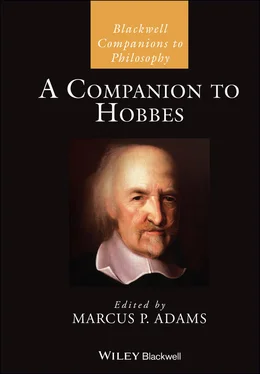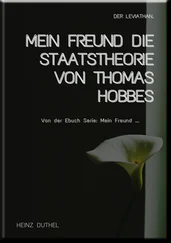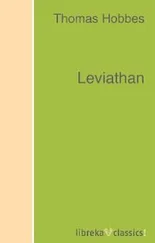Where the tradition sought to develop an account of mathematics that makes it independent of the structure or contents of the material world, Hobbes pursued a radically materialistic treatment of the subject. The basis of this program is developed in chapter 8of De corpore , which bears the title “Of Body and Accident.” In De corpore VIII.4 Hobbes offers a definition of the term ‘magnitude’ with the remark that “The Extension of a Body, is the same thing with the MAGNITUDE of it, or that which some call Real Space ” (EW I.105). Having identified magnitude with the extension of body, Hobbes proceeds in De corpore VIII.12 to define the geometric terms ‘point’ and ‘line’ in terms of the central concept of body:
Though there be no Body which has not some Magnitude, yet if when any Body is moved, the Magnitude of it be not at all considered, the way it makes is called a LINE, or one single Dimension; & the Space through which it passeth, is called LENGTH; and the Body it self, a POINT; in which sense the Earth is called a Point , and the Way of its yearly Revolution, the Ecliptick Line .
(EW I.111)
Surfaces and solids are then definable in the same manner. This account of magnitude has an obvious connection to Hobbes’s materialistic ontology. Because he takes only bodies to be real, and because he maintains that it is only through the motion of bodies that anything can be brought about, Hobbes must base all of mathematics on the principles of matter and motion. Mathematical objects must therefore be interpreted as bodies or things produced by the motion of bodies. In particular, the geometric point is a body, which requires that the point be divisible and have magnitude (even if that magnitude is disregarded), while lines, surfaces, and solids arise from the motions of points, lines, and surfaces, respectively.
At first sight, it might seem that there is no place for arithmetic in this scheme. Taking space, motion, and body as fundamental concepts might make tolerable sense of geometry, but it is unclear how this can work for arithmetic. Classical authors drew a firm distinction between the continuous magnitudes of geometry and the discrete “multitudes” of arithmetic. Geometric magnitudes such as lines, angles, surfaces or solids are divisible into lesser magnitudes of the same kind (lines divide into lines, angles into angles, etc.). In contrast, the discrete multitudes of arithmetic were taken to be only finitely divisible and to be ultimately composed from indivisible units. Viewed in this way, geometry and arithmetic are fundamentally different sciences with essentially different objects. Hobbes, however, held that arithmetic could be based on the uniform division of continuous magnitudes into equal parts. As he put the matter, “because any given continuous magnitude can be divided into any number of equal parts, with its ratio to any other magnitude remaining unchanged, it is manifest that arithmetic is contained in geometry” (OL IV.28).
3.1.2 Hobbes on Geometric First Principles
Hobbes’s understanding of geometry as a generalized science of material bodies puts him at odds with the traditional notion that the objects of geometrical investigation are radically distinct from the realm of material things. The difference becomes clearer when we examine the Hobbesian treatment of first principles, and more specifically the definitions upon which the science of geometry is based. True to his materialistic principles, Hobbes demands not only that all geometric objects be defined as bodies, but also that proper definitions must identify the causes by which such objects are produced, with the further requirement that the only such causes can be motions. The result is a conception of geometry that diverges significantly from the tradition.
Euclid defines the point as “that which has no part,” while a line is defined as “breadthless length” ( Elements , Book I, Defs. 1, 2). Hobbes argues in De Principiis et Ratiocinatione Geometrarum (hereafter PRG ) that these definitions are ambiguous:
these words “which has no part”, can be understood in two ways, either for undivided (a part indeed not being understood except where a division has gone before) or for indivisible , because it is by its nature incapable of division. In the former sense a point is rightly called a quantity, in the latter not; as all quantity is always divisible into divisibles. And thus if a point is indivisible, every line will lack breadth, and because there is nothing long that does not have breadth, the line would clearly be nothing. Although length is indeed not broad, nevertheless everything long is broad. It seems that Euclid himself was also of this opinion, that although a point has no parts actually, it is nevertheless divisible potentially and is a quantity, otherwise he would not have postulated that a straight line can be drawn from a point to a point. 5Which is impossible unless the line has some breadth.
(OL IV.391)
Elaborating this doctrine in reply to some of Wallis’s criticisms, Hobbes insisted in Six Lessons to the Professors of the Mathematiques (hereafter SL )
That which is indivisible is no Quantity; and if a point be not Quantity, seeing it is neither substance nor Quality, it is nothing. And if Euclide had meant it so in his definition, (as you pretend he did) he might have defined it more briefly, (but ridiculously) thus, a Point is nothing .
(EW VII.201)
Hobbes held that the Euclidean definitions of point, line, and surface can be remedied by resolving the ambiguity. He asserted in Dialogue 1 of Examination that understanding the point as a divisible body whose magnitude disregarded implies that “the quantity of a point is not nothing, but rather not computed. Nor is the point itself nothing, or indivisible, but undivided” (OL IV:33).
The flaws in other Euclidean definitions cannot be so easily mended. In particular, Euclid’s definition of ‘ratio’ is entirely uninformative, reading; “A ratio is a sort of relation in respect of size between two magnitudes of the same kind” ( Elements , Book V, Def. 3). Hobbes dismisses this in SL Lesson 2 as “insignificant” and amounting to no more than saying a ratio “is a whatshicalt habitude of two Quantities ” (EW VII.229). In its place he offers a definition that takes a ratio to be the comparison of the relative magnitude of two bodies. He claims in De corpore XI.3 that a ratio is the “Excess or Defect” of one body when compared with another (EW I.133). The ratio between two bodies therefore expresses the amount by which they differ in some quantity. As it happens, there are various kinds of quantities associated with bodies: volume, mass, velocity, temperature, density etc. Moreover, the difference in these magnitudes can be expressed in alternative ways. Consider two bodies, one with a weight of 5 kg, the other weighing 3 kg This difference could be expressed as the arithmetical ratio of 2 kg, corresponding to 5 – 3, or it could be expressed as the geometric ratio 5:3, arising from the division of five by three. In general, it is the geometric ratio that is of interest when volumes, arc lengths or areas are compared. Although many kinds of quantities can stand in geometric ratios, Hobbes holds that any ratio can be “exposed” or “exhibited” by displaying two straight lines whose lengths stand in the desired ratio.
Where Hobbes dismissed the Euclidean definition of ‘ratio’ as uninformative, he took the definition of ‘same ratio’ to be both overly complex and capable of definition from more basic principles. In Euclid’s presentation, the definition reads
Читать дальше












